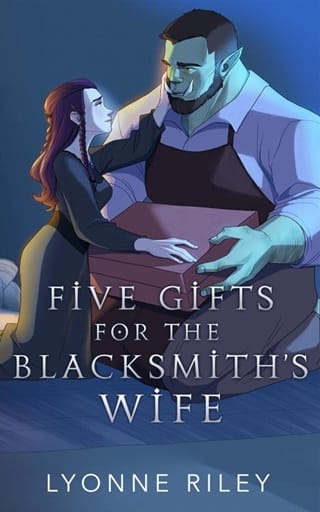Twenty-Five Four Moons
TWENTY-FIVE
Four Moons
MARY
I expected to reunite with the men as soon as I'd finished my bath and dressed, but instead I was met by the Sunjani novice and led into an underground passageway.
Nerves, settled by the bath, prickled back to life.
"Where are we going?" I asked in Mereish, supplied by Tane.
The Sunjani blinked at my change of language. "Your Mereish is very good." Her own was pleasantly accented, with the light vowels and soft stops of her native tongue. "My name is Nitha."
"I'm Mer," I said, using an Usti form of Mary.
I was aware that my facial structure was staunchly Aeadine, with the broad cheekbones, small mouth and nose common to the midlands, but the chances of her recognizing that were slim, and the Usti ancestry I claimed was notoriously mixed.
"Where are we going?" I repeated, hoping to distract her.
"I am taking you to the Oruse. Our shrine." Nitha turned her attention back to the tunnel ahead. It wasn't as dank as I expected, the floor and walls dry and brightly lit with oil lamps on silvered iron hooks. "You must pay your respects."
Hidden in my bones, Tane stirred. Whatever I sensed lies this way. Mary, it feels like another ghisting.
Samuel said there was ghisten wood here.
I do not speak of doors and lintels. This ghisting has not been harvested.
But we are nowhere near a Ghistwold.
Precisely.
Curiosity deepening, I asked, "Have my companions already paid their respects?"
"Your friend with the pale hair will join us soon."
"Not the others?"
Nitha wasn't a terrible liar, but there was evasiveness in her eyes as she said, "They were not summoned. You will see them at table, regardless."
Perplexed and more than a little wary, I fell silent.
The tunnel was long enough for me to recognize we must have left the monastery grounds. We reached another set of stairs that broadened as they rose, each rock-hewn step worn with age and smooth in the lanternlight. We passed several monks in low, smiling conversation and two novices with empty baskets and scuttling feet. They all nodded to us, but kept their eyes from my face.
"Why won't they look at me?" I asked. Surely not everyone at the monastery was in hiding and would act the same way.
"The Saint summoned you but has not seen you yet," my guide said.
The beginnings of suspicion began to trickle between Tane and myself.
"No one else should see me before this Saint?" I clarified.
"Yes."
"But you may?"
She smiled. "It is not a rule—just a courtesy. This way."
At the top of the stairs my guide turned right, moving swiftly. Natural light touched the slate floor beneath our slippers, filtered through tall, narrow windows as we passed down a short hallway. At its end, an ancient, almost entirely circular archway of alternating yellow, blue and white stone opened into a vaulted, also circular chamber.
I'd been in places of worship before, from my village's small chapel with its singular, gold-leafed icon of the Aeadine Saint in his scarlet crown to Hesten's gargantuan cathedral, its floor set with as many tombstones as tiles. This place had the same sense of gravity and reverence, but… more. Every inch of stone, wood, plaster, gold, ivory, anything in the space that might be carved was, and everything that could not be was painted with intricate Mereish psalms and patterns.
I shared Tane's sense of a presence now, a similar feeling to when I stood next to Hart 's figurehead or we encountered another ghisten ship at sea, but more elusive. There was another ghisting in this room. But where? In the carvings? In the door, as a guardian?
As in an Aeadine chapel, I expected a saint's statue to be central to the chamber, properly pious and surrounded by offerings. But here I saw only a carved wooden pillar, graced by a beam of sunlight from a small, circular window.
I fixed my eyes on the pillar.
"The walls show the life of Saint Adalia," my guide said, moving to the center of the chamber. Rows of cushions covered the floor in apparently random lines, but when I followed Nitha's gaze, I realized they were positioned to face different sections of the carvings.
The nearest fa?ade was carved of nearly black wood. Inlaid with pieces of opal, it depicted a woman crowned in beams of light, holding out her hands to rows and rows of kneeling onlookers. Her left hand cradled a small sun, its light illuminating half her body. The other half was cast in shadows, highlighted by a gentler, silver illumination from a full moon cradled in her right hand. The moon, I noticed, she held higher than the sun—one at her breast, one at her hip.
Facing Adalia, behind rows of carved, kneeling supplicants, were two robed figures. One was male, one ambiguous. Both mirrored the Saint with golden sunlight on half their bodies and silver moonlight and shadows on the other. The main differences, I saw, were in the positioning of their hands and the phases of the moons. One held the sun higher than the moon, while the final figure held them even. One moon was a sickle, the other a nearly invisible orb of obsidian.
"They represent the three suns and three moons of the Other," Nitha murmured. She seemed pleased that the motif had stolen my focus and directed me on to the next section of the story. The three figures appeared again, their hands—the sun and the moon—held at new levels. "They balance the tides and in the spring summon the Black Tides."
The pillar in the center of the room still drew Tane's attention, but my human eyes fell on the final motif, where all three figures stood waist-deep in dark water. Their hands were held evenly here, the suns draped in cloth, and three perfect obsidian moons set in a row. Behind them, a fourth obsidian moon hung, bathing them all in shadow.
"What is this?" I asked.
"The true Black Tide," Nitha explained. She began to move towards the central pillar, and something in her posture told me to follow. "When the dark of the Other's moons aligns with that in our world. Four new moons, two Black Tides—the first greater than any natural tide has a right to be, and the second surpassing even that. It happens every few centuries. We are fortunate to live to see one."
I startled. "We will see one? When?"
"This spring."
A new rush of questions clustered on my tongue, but they stalled as we rounded the central pillar and my sense of the ghisting flooded back.
There, carved into the other side, was a woman. Adalia Day. She was tucked into the wood as if it were water, every angle fluid and smooth and so utterly lifelike that I feared my mind played tricks on me. She clasped her arms loosely at her chest, cradling the sun and the moon to her skin like precious, breakable things. Her head was bent to one side, hair draped to her ankles, her eyes closed, and her body clothed in just the hint of a spidersilk gown.
As I stared, a ghisting unfolded from the wood. The perfect image of her carving, her statue, her host.
Adalia Day was no simple icon, no rendering of a distant, long-lived woman.
She was a ghisting.
 Fullepub
Fullepub 



